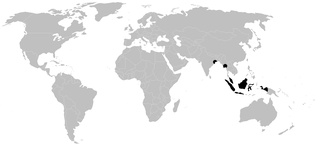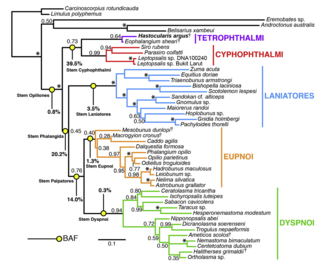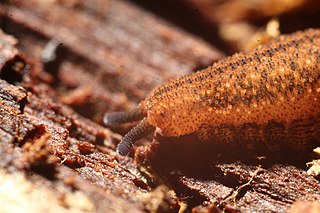
Arachnida is a class of joint-legged arthropods, in the subphylum Chelicerata. Arachnida includes, among others, spiders, scorpions, ticks, mites, pseudoscorpions, harvestmen, camel spiders, whip spiders and vinegaroons.

The Opiliones are an order of arachnids colloquially known as harvestmen, harvesters, harvest spiders, or daddy longlegs. As of April 2017, over 6,650 species of harvestmen have been discovered worldwide, although the total number of extant species may exceed 10,000. The order Opiliones includes five suborders: Cyphophthalmi, Eupnoi, Dyspnoi, Laniatores, and Tetrophthalmi, which were named in 2014.

Cretoperipatus burmiticus is an extinct species of velvet worm that is known from the Burmese amber in Kachin state of Myanmar, originating from the Cenomanian-Turonian stages of the Late Cretaceous.

The Eupnoi are a suborder of harvestmen, with more than 200 genera, and about 1,700 described species.

Cyphophthalmi is a suborder of harvestmen, colloquially known as mite harvestmen. Cyphophthalmi comprises 36 genera, and more than two hundred described species. The six families are currently grouped into three infraorders: the Boreophthalmi, Scopulophthalmi, and Sternophthalmi.

The Sironidae are a family of harvestmen with more than 60 described species.

Troglosironidae is a family of harvestmen with seventeen described species in a single genus, Troglosiro, which is found on the island of New Caledonia, in the Pacific Ocean.

The Neogoveidae are a family of harvestmen with 27 described species in eight genera. However, eight species of Huitaca, 17 species of Metagovea and 12 species of Neogovea are currently awaiting description.

The Stylocellidae are a family of harvestmen with about 40 described species, all of which occur in Southern or Southeastern Asia. Members of this family are from one to seven millimeters long. While Stylocellus species have eyes, these are absent in the other two genera.

The Pettalidae are a family of harvestmen with 75 described species in 10 genera. Several undescribed species are known or assumed in some genera.

Ischyropsalididae is a family of harvestmen with 35 described species in 3 genera, found in Europe and North America.
The Zalmoxidae are a family of harvestmen within the suborder Laniatores.

Harvestmen (Opiliones) are an order of arachnids often confused with spiders, though the two orders are not closely related. Research on harvestman phylogeny is in a state of flux. While some families are clearly monophyletic, that is share a common ancestor, others are not, and the relationships between families are often not well understood.

Peripatidae is a family of velvet worms. The oldest putative representatives of the family herald from Burmese amber dated to the mid-Cretaceous, around 100 million years ago, with representatives from Dominican and Baltic amber attesting to a broader distribution in the Palaeogene / Neogene; molecular variability suggests that the family's crown group may have arisen in the early Mesozoic.
Zalmoxis is a genus of harvestmen, within the Zalmoxidae family. They are found in tropical Australia, Borneo, New Guinea, the Philippines and on Pacific islands.
Gonzalo Giribet is a Spanish-American invertebrate zoologist and Alexander Agassiz Professor of zoology working on systematics and biogeography at the Museum of Comparative Zoology in Harvard University. He is a past president of the International Society for Invertebrate Morphology, of the Willi Hennig Society, and vice-president of the Sociedad Española de Malacología.

Kumbadjena is a genus of velvet worms in the family Peripatopsidae. All species in this genus are ovoviviparous, all have 15 pairs of oncopods (legs), and all are found in the southwest of Western Australia.

Neosiro exilis is a species of mite harvestman in the family Sironidae. It is found in North America.
Tithaeidae is a family of the harvestman infraorder Grassatores, Epedanoidea with about 40 described species.












